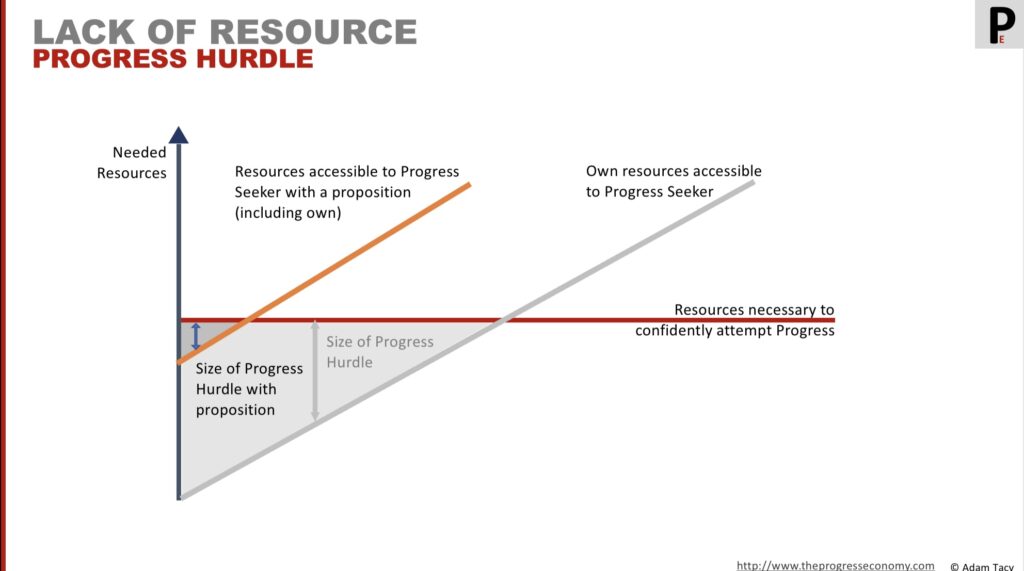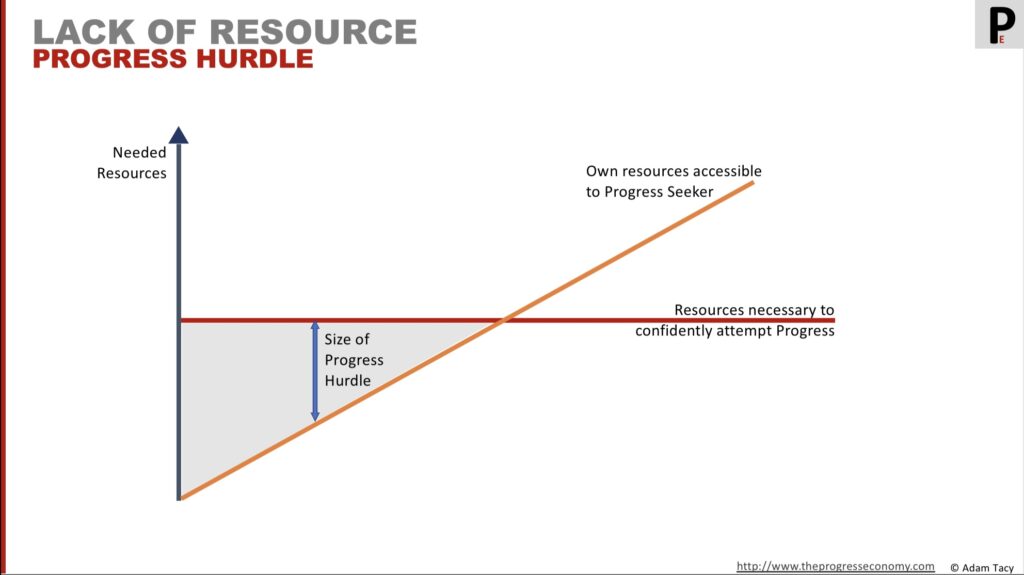What we’re thinking
Often progress seekers lack the resources needed to make progress: skills, knowledge, tools, maybe strength, time, etc. This is the fundamental progress hurdle in the progress economy – the lack of resources progress hurdle.
Seekers may be innovative and create new resources, or reuse existing resources in novel ways. Or they may turn to a progress propositions (which offer supplementary resources).
Whilst the intention of progress propositions is to reduce this hurdle, they may not fully lower it and may even introduce new lack of resources.
Helpers are incentivised to minimise this hurdle by their need to maximise service exchanges (direct, or more likely, indirect).
A lack of resource
Ready to fly to yourself to space? Probably not (unless you’re Elon Musk or Richard Branson). Us mere mortals lack the resources on our own to do so. And this is so often the case in many progress attempts we wish to make.
Generically, we can say we might lack:
- knowledge of the progress-making activities to make progress
- sufficient skills to execute one or more of those progress-making activities
- other operant resource than skills or knowledge (such as creativity, or physical strength, or…)
- operand resources, such as goods and tools* we feel necessary for those activities
- the time
* items that freeze particular skills and knowledge for distribution and that are unfrozen during a progress-making activity
This aligns, although slightly expands, with the literature, where the authors of “Reinventing your business model“ identify:
four most common barriers keeping people from getting particular jobs done: insufficient wealth, access, skills, or time.
Johnson, M.W., Christensen, C.M. and Kagermann, H. (2008) “Reinventing your business model“, HBR
Although we see lacking resources as a hurdle rather than barrier. A barrier implies a block, whereas a hurdle aligns with the observation some seekers will attempt progress anyway. And we see wealth slightly differently.
Of course, we could engage Virgin Galactic to fly us there. And this is an example of a progress proposition. They offer supplementary resources to help us make progress (for, presumably, a sizeable level of service exchange). But as we’ll see, the offered resources may not eliminate the hurdle and may introduce new lack of resources.
Let’s explore this hurdle.
Lack of resource progress hurdle
Here’s how we can visualise the lack of resource hurdle:
A seeker judges the minimum level of resources they believe they need in order to make a progress attempt (the horizontal line in the diagram). Additionally they judge the level of resources they have available to them. Both these judgements are unique and phenomenological to the seeker and unique to the progress attempt.
The size of the progress hurdle indicates the extent to which their existing accessible resources fall below their minimum to attempt progress.
Impact of engaging a proposition
Seekers may look to engage a progress proposition in an attempt to overcome their lack of resources. Propositions offer supplementary resources, specifically:
- a proposed series of progress-making activities
- a progress resource mix (a proposition specific combination of employees, systems, data, goods, physical resources, locations)
These supplementary resources offer to potentially address a seeker’s lack of resource as follows:
| resource lack | addressed by progress proposition’s… |
|---|---|
| knowledge of progress making activities | proposed series of progress-making activities |
| skills to execute above activities | employees and operand systems (e.g. Artificial intelligence), if offered, in the progress resource mix |
| other operant resources | employees and operant systems, if offered, in the progress resource mix |
| operand resources required | goods, physical resources, operand style systems, and locations, if offered, in the progress resource mix |
| time | position towards the relieving end of the progress proposition continuum |
Engaging a proposition means that progress is now a joint endeavour. As we head towards the relieving end of the proposition continuum the helper offers increasingly more resource, reducing potential for seeker’s lack.
The effect of a proposition should be to shift seeker’s resource judgements leftwards on our visualisation. Reducing the size of the progress hurdle.

However, a proposition may not completely eliminate a seeker’s lack of resource. For instance, it may not provide all the tools required. Or it might be towards the enabling end of the progress proposition continuum (thus not addressing lack of time).
A proposition may introduce a new lack of resource. Imagine a proposition offering mini one-person helicopters to solve progress sought of making short journeys in a context of crowded cities. That likely introduces a new lack of skills relating to flying helicopters (unless a system component solves that).
Propositions also give rise to five additional progress hurdles, which we discuss elsewhere.
Relating to value
Norman, in “Reframing business: When the map changes the landscape” (2001) informs us that the amount of information, knowledge, skills and other operant resources that a [seeker] can access and use is a key aspect of their ability to create value.
In the progress economy we of course see this as a key aspect of their ability to make progress. From which value emerges and can subsequently be recognised.
We can say that reducing a lack of resource should increase progress made. That results in more value being created.
Relating to innovation
Innovation, then, is about finding or creating new resources, or using existing resources in new ways or combinations in order to make more progress (or existing progress better). We can look at this from the seeker and helper perspective.
seeker’s perspective
A seeker’s resources typically come from:
- finding operand resources in nature
- observing and copying others
- creative thinking
- trial and error
This is the human story of bootstrapping knowledge and skills into an ever increasing complex progress-making world. We’d probably refer to it as MacGyver-ing. An approach long favoured by lovable eccentric innovators.
On top of this, and more likely in today’s world, seekers acquire resources from previous engagements with progress propositions. Those leave the seeker with operand and operant resources which can be re-used in new progress attempts either as designed or in novel ways and/or novel combinations.
And there’s another part to this. Sometimes a seeker turns their newly acquired resources into an offering to help others make progress. The progress seeker becomes a progress helper. Doing so to engage in more service exchange to further their other progress attempts.
helper’s perspective
Helper’s are incentivised to innovate their resources offered due to their need/wish to engage in service exchange (direct or usually indirect).
If they don’t offer ways to help a seeker make better progress than other helpers, then they will lose exchanges.
Additionally, seekers’ progress sought and origins are known to evolve over time. Not evolving the resources offered to match/anticipate is a sure way to lose out on exchanges.
There are several ways for a helper to enhance their resources. They can invest in research and development or engage in creative trial and error processes on their own.
Helpers can “carry” resources from other industries or markets. A good example is QR codes, which initially appeared in the automobile industry but are now widely used for ticketing, access control, information sharing, and various other applications.

They might also engage with another helper to get training for employees or improve internal systems. Or align resources from another helper through forming an ecosystem or acquisition.



Let’s progress together through discussion…